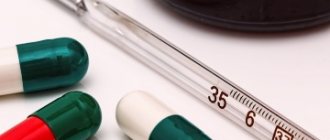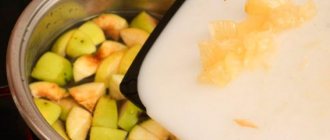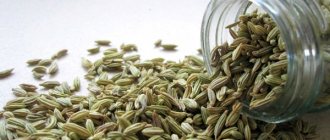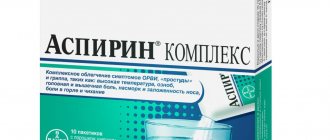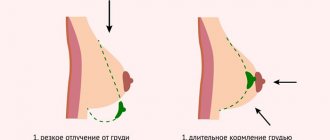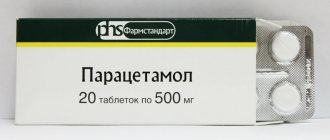A high temperature during breastfeeding takes almost every mother by surprise, because it is necessary to immediately take measures for treatment and resolve the issue of feeding the baby. Due to reduced immunity, the body of a nursing mother is quite vulnerable, and there may be several reasons for the rise in temperature.
The reasons for fever during breastfeeding may be different, but interruption of feeding during treatment will only be necessary in exceptional cases.
Causes
All reasons that can cause an increase in temperature in a breastfeeding woman can be divided into three separate groups:
Establishing the cause is very important, since tactics will differ in different cases. An increase in temperature in the first weeks of the postpartum period can be caused by the occurrence of inflammatory diseases, for example, mastitis, inflammation of sutures, endometritis and others.
When should you see a doctor?
If a woman has noted at least one of the listed pathological symptoms described above, then she needs the help of a specialist as soon as possible; self-medication is not acceptable here. If a woman’s temperature lasts for more than 2-3 days after childbirth , and no other symptoms are detected, it may be due to other chronic diseases. In this case, it is also necessary to visit a doctor who will make the correct diagnosis and determine the causes of the temperature. A young mother must always be healthy and full of strength, since the health of the child depends on her.
Thus, an increase or decrease in body temperature should not go unnoticed, since the postpartum period is considered quite dangerous for a woman, during which quite a few serious illnesses can occur. Therefore, it is recommended to take care and treat yourself very carefully.
How to measure temperature?
If a nursing mother measures her temperature during feeding or immediately after it (as well as after pumping) under her arm, then readings of 37.1-37.3 degrees or slightly higher will be considered normal. This is due to the formation of milk deep in the mammary glands, as well as the release of heat by the muscle cells of the chest during feeding. That is why it is recommended to measure the temperature in the armpit area about half an hour after feeding or pumping. It is also important to wipe off the sweat before taking measurements, as water tends to absorb heat and the presence of sweat in the armpit can make the result unreliable.
Causes of low body temperature after childbirth
A drop in temperature after childbirth is rare, but it worries mothers no less. In approximately 6-8% of women in labor, the temperature drops to 35.5°C on the 6th day after birth due to anemia or postpartum thyroiditis (dysfunction of the pituitary gland), which provides hormones to the thyroid gland.
Rarely does thyroiditis develop into hypothyroidism. It will not be superfluous to take a general blood test and a blood test for thyroid hormones, namely TSH. If blood tests are normal, most likely the decrease in body temperature is due to the temporary physiological state of the woman; treatment in this case is not required.
When can you breastfeed?
When the cause of the elevated temperature is a viral infection, feeding may not be stopped. Firstly, the mother became a carrier of the virus even before the external manifestations of infection, so the virus could already have entered the baby’s body. Secondly, after the virus entered the mother’s body, the production of antibodies began, which will be supplied to the baby through breast milk. This can prevent the disease in the baby or make its course easier. Additionally, deciding to stop breastfeeding due to a fever can harm a woman's breasts, causing congestion and mastitis.
When is it not possible?
Contraindications to continued breastfeeding may be due to:
Prescribing antibiotics is not always a reason to stop breastfeeding, but it happens that the mother has to take exactly those types of antibiotics that can harm the baby’s body. In this case, the woman is advised to temporarily stop breastfeeding.
If a woman has mastitis, the question of continuing breastfeeding should be decided individually. Mastitis is not an absolute contraindication, but most often it is caused by infection with Staphylococcus aureus, and there is a high risk of the baby becoming infected with this microorganism.
In cases where a mother’s existing chronic disease has worsened, for example, sinusitis, pyelonephritis or bronchitis, there are often no contraindications to continuing breastfeeding. Among all the infections that occur in adults in a chronic form, only syphilis, active tuberculosis, viral hepatitis C and B, and HIV can act as an obstacle to breastfeeding.
Adviсe
A nursing mother with a fever should consult a specialist to accurately determine the cause of the elevated temperature. In addition, the doctor will recommend treatment that is compatible with breastfeeding. If six weeks have not yet passed after giving birth, you should contact your obstetrician-gynecologist. If symptoms of an intestinal infection or cold appear, you should call a therapist at home.
In case of acute viral infection, the mother should try to protect the baby from airborne infection. It is recommended to isolate the baby from the mother at least during sleep, and also to frequently ventilate the room. When feeding a baby or caring for an infant, a sick mother should wear a disposable or gauze (4-layer) bandage, which should be changed every two to three hours.
Causes of this disease
Before you start lowering your temperature while breastfeeding, find out the reason for this condition.
In most cases, this is caused by ARVI, but in a nursing woman during the postpartum period, other reasons may lead to this:
Before looking for signs of these diseases, make sure you know how to measure your body temperature correctly. So in the armpit of a nursing woman it will always be slightly higher than 37, so it is better to measure it in the elbow or groin.
Is it possible to feed the baby?
A temperature of up to 38-38.5 during breastfeeding in itself is not a reason to switch to formula. Quite the opposite - doctors say that feeding a child is even beneficial, especially if the cause of the temperature is ARVI.
Modern doctors say: breastfeeding at fever is possible and even necessary
This is explained by the fact that this period is characterized by the production of antibodies, which pass to the baby through breast milk, after which they improve his immunity.
Therefore, feeding helps the baby fight viral diseases in the future. It is also absolutely necessary to put the baby to the breast if the mother has developed lactostasis - the baby will empty the breast and thus help avoid serious complications.
However, sometimes you will have to stop breastfeeding. If a young mother’s temperature is accompanied by the following factors, breastfeeding is strictly forbidden:
The dangers of ignoring this problem
You should not ignore the symptoms; this may be a sign of a serious illness.
High body temperature is always a reason to pay attention to your health. Loss of breastfeeding is the least that can happen if the necessary treatment is not provided. Particularly severe cases can provoke the following consequences:
All these diseases are necessarily accompanied by fever and fever, so if you know how to measure the temperature after childbirth, but are sure that it is really elevated, do not ignore this symptom. Be sure to monitor all changes in your condition, and if you have the slightest suspicion of a serious illness, consult a doctor.
Folk methods of struggle
You can bring down the temperature using traditional methods, for example, using vinegar
If you are sure that you do not need to consult a doctor and that no dangerous symptoms accompany your condition, then you can try to reduce the fever yourself. Thinking about what can be taken for fever while breastfeeding, many women are inclined to use traditional methods of treatment. There are not so many of these methods - drinking with the addition of antipyretic components or rubbing.
If folk recipes do not help, then you need to ask a doctor how to lower a mother’s temperature while breastfeeding. He will recommend safe medications.
What does elevated temperature indicate during lactation?
Elevated temperature during feeding may have the following characteristics:
- Physiological.
- Pathological.
The physiological process is associated with the production of milk by the mammary glands.
Doctors consider a temperature above 37.6°C to be pathological, which lasts for a long time and is accompanied by other symptoms of illness.
The most common sign of fever immediately after the birth of a baby is complications during childbirth:
- suture dehiscence after cesarean section or episiotomy;
- endometritis;
- postpartum thrombophlebitis;
- stagnation of milk (lactostasis) in the mammary glands.
The postpartum period is considered critical, because a woman goes through a difficult journey, which is fraught with a lot of complications. Open birth canals, ruptures, hormonal shock - this is a list of not all dangerous conditions. Any of them allows the infection to easily penetrate the mother’s body, so the temperature of a nursing woman is one of the important markers of her health status.
Childbirth often begins a series of various inflammations: endometritis, mastitis. This list also includes postpartum thrombophlebitis
- inflammation of the venous wall, as a result of which blood clots form inside the vessel. This is a very serious postpartum complication, the marker of which is temperature and corresponding symptoms.
Some time after birth, the cause of fever can be:
- mastitis;
- pyelonephritis;
- colds. Find out what a nursing mother should do if she has a cold.
Fever often accompanies a cough, runny nose, and sore throat. Colds are the most common cause of high fever.
This is followed by stagnation of milk in the breast (lactostasis). Lactostasis differs from mastitis in the absence of swelling and hyperemia of the mammary gland. Once the outflow is restored, fever and pain disappear without treatment. Lactostasis is a common phenomenon and without treatment can lead to a more serious complication – mastitis. In this case, the temperature rises greatly (up to 38°C and above) and there is no relief from expressing milk.
The main symptom of mastitis is the presence of a painful lump in the breast and redness of the skin over it, which is accompanied by an increase in temperature to 38 °C. If you do a blood test, the ESR will be increased and the leukocytes will be increased. There is severe intoxication with malaise and headache. Without treatment, purulent mastitis develops.
Normal temperature during breastfeeding
With the first influx of transitional milk (on the 3-4th day after birth), the endocrine system is rebuilt to a new regime. Now the body's resources are aimed at ensuring lactation and recovery after childbirth. Due to the increased load, the immune system reacts with a low-grade fever: the thermometer shows 1-2 degrees above the individual norm (37-37.5 °C).
Typically, the temperature of a healthy person varies during the day from 36.5 °C to 37 °C. The indicator varies depending on the time of day, physical and psychological stress. Low-grade fever after childbirth is a normal state of the female body, which is influenced by 2 factors: postpartum stress and hormonal changes.
The temperature of a nursing mother can normally be up to 37.5 °C.
The greater the accumulation of breast milk in the glands, the more local immunity is loaded, and the higher the temperature rises. If a woman is diagnosed with mastitis (inflammation of the mammary gland), the indicator increases to 39 °C.
It is recommended to measure the temperature an hour or 30 minutes before feeding. As the milk flows in, the thermometer rises, and after the sucking stops it returns to normal.
Research results
Breast skin temperature was measured during breastfeeding in 11 mothers a total of 47 times using Coretemp CM-210 (Terumo Corporation, Tokyo, Japan) to study changes in local temperature during breastfeeding. In both glands, skin temperature was significantly higher than basal skin temperature (from the start of suckling to 5 minutes after completion of feeding). The average skin temperature of the breast before breastfeeding in the period from 4 days to 8 weeks after birth was significantly higher than in the first 1-2 days after birth. These results show that breast skin temperature rises during the first days after birth and remains high during suckling and up to 5 minutes after the baby has finished feeding. Thus, the lactation process is accompanied by a local rise in temperature.
Reasons for rising temperature
For a healthy person, a temperature in the range from 36.5 to 36.9°C is considered normal. But for women who are breastfeeding, it is somewhat different from these indicators. Typically, the thermometer readings for lactating mothers are several notches higher. This is due to the flow of milk into the mammary glands. Milk has properties that increase body temperature. The more time has passed since the last feeding, the higher it is. As a rule, temperatures are higher before feeding than after.
Measuring body temperature during lactation in the armpit does not give reliable results. Therefore, to determine the correct indicators, it is necessary to take measurements in the elbow bend. In this case, you must wait at least 30 minutes after feeding. The normal number on the thermometer is up to 37.1°C. At the time of feeding, it can rise to 37.4 ° C. This temperature is physiological, that is, normal for the lactation period. If a nursing mother does not experience any discomfort or pain in the chest or other organs, then there is no need to worry or take any action. Doctors consider a condition pathological (abnormal) when body temperature rises to 37.6 ° C or higher, as well as if it is accompanied by other painful sensations. Elevated body temperature can be a consequence of diseases such as:
- lactostasis (stagnation in the milk ducts) and mastitis (inflammation of the mammary gland);
- diseases of the ENT organs (ear, nose and throat) of a bacterial nature (sore throat, sinusitis, tonsillitis);
- influenza and ARVI (acute respiratory viral infection);
- acute form of chronic diseases;
- suture dehiscence/inflammation after cesarean section;
- acute form of poisoning or rotavirus infection;
- inflammation in the uterus (endometritis);
- thrombophlebitis (inflammation of the walls of a vein with the formation of a blood clot), which occurs after childbirth;
- other diseases of internal organs (kidney inflammation and others).
The temperature should be reduced only if it has risen above 38°C. Knocking down lower temperatures can only do harm.
A high body temperature can be a consequence of either a common cold or a more serious illness.
Lactostasis and mastitis
Lactostasis is a congestion in the mammary glands that occurs due to blockage or spasms of the milk duct, excess production of breast milk, difficulties with breastfeeding, sudden cessation of breastfeeding, wearing an incorrectly selected bra (too tight). This phenomenon can be recognized by soreness of the mammary gland, pain during feeding or pumping, lumps and redness in certain areas of the breast. If lactostasis is not recognized in time and the necessary measures are not taken, it can develop into a more serious disease - mastitis. Breastfeeding in this condition is not only not prohibited, but is also necessary to eliminate milk stagnation.
Around the sixth month after giving birth, I began to experience unpleasant pain during feeding. At first I thought that the breast was simply “tired” from endless sucking, since at night the child very often tried to eat and just suck on it instead of the “pacifier.” The pain was very strong, I had to clench my teeth from how painful it was. I did not immediately suspect that I had lactostasis until I saw a white dot on the nipple, which was a “plug” that prevented milk from coming out, and I felt small lumps. Only then did I understand the cause of my pain. This happened due to a tight bra that pinched the mammary gland. Since one breast is slightly smaller than the other, only one was affected.
Lactostasis can be caused by tight underwear, incorrect application technique, or spasm.
Mastitis is inflammation of the mammary gland. It is characterized by severe pain, swelling, the appearance of lumps, hyperemia (redness) of the breast, and a sudden increase in body temperature. This is a very dangerous disease that can manifest itself with complications such as abscess, necrosis, blood poisoning and even death. Its causes are bacterial infection, most often staphylococcus. But mainly it occurs due to advanced lactostasis. Due to the fact that milk remains in the mammary gland for a long time, good conditions are formed in this place for the proliferation of pathogenic organisms, the reproduction of which leads to inflammation, fever and the appearance of a purulent process.
The answer to the question about the possibility of continuing breastfeeding with mastitis depends on the severity of the disease. With a mild form of the disease, feeding can be continued. Some mothers are afraid that pathogenic microorganisms will enter the child's body. These fears are unfounded. But in some cases, breastfeeding should be stopped. This must be done in the following conditions:
- Purulent inflammation. Purulent discharge can enter the baby’s body and provoke infections that are dangerous for an early age.
- Treatment with antibiotics. Antibacterial drugs tend to pass into breast milk and through it into the baby’s body.
- Damage to the nipples and parapapillary tissues. Through them, dangerous microorganisms can enter the baby’s body. Active sucking also contributes to even greater damage to the skin, slowing down its restoration and healing.
- Strong pain. Unbearable painful sensations during feeding can develop in the mother a persistent aversion to breastfeeding in general and subsequently lead to the disappearance of breast milk.
Mastitis is manifested by severe pain and high body temperature, redness in the area of inflammation and general deterioration of the condition
If you suspect mastitis, you should immediately contact a specialist (gynecologist or mammologist) to begin timely treatment.
You can distinguish lactostasis from mastitis by the following signs:
- Measuring body temperature during lactostasis most often leads to different readings in different armpits. Whereas with mastitis, the difference in these readings will be much less.
- With lactostasis, after pumping or feeding, pain and temperature decrease. With mastitis, emptying the breasts does not lead to relief.
Video: what to do with lactostasis
Rotavirus infection
This disease is also called intestinal or stomach flu, rotavirosis, rotavirus gastroenteritis. The cause of this disease is infection with rotavirus. Most often, children get it, but adults (including nursing mothers) are also at risk.
The virus is most often transmitted through food (through poorly washed hands, fruits/vegetables), less often - through airborne droplets from a sick person or a virus carrier who may not show symptoms of this disease. The disease is characterized by an acute onset and the following symptoms:
- pain in the abdomen;
- nausea and vomiting;
- weakness in the body;
- high temperature up to 38°C;
- diarrhea;
- red eyes;
- sore throat condition.
This disease is dangerous due to severe dehydration, which occurs due to frequent diarrhea or vomiting.
There is no need to stop breastfeeding if you have rotavirus infection. Mother's milk contains antibodies that can protect the baby from this disease. But a nursing woman should not forget about such precautions as careful hygiene and the use of a gauze bandage, which should cover not only the mouth, but also the nose.
Breastfeeding should be stopped only if treatment with medications that are incompatible with breastfeeding has been prescribed.
Rotavirus infection manifests itself as diarrhea, vomiting, abdominal pain
Endometritis
This is an inflammation of the endometrium (inner uterine layer). It occurs as a result of pathogenic microorganisms entering the inner layer of the uterus. Symptoms of this disease are:
- high body temperature (in severe cases of the disease up to 40–41°C);
- general weakness;
- chills;
- headache;
- nagging pain in the lower abdomen and lower back;
- prolonged bleeding after childbirth, which should end 1.5–2 months after birth, or its recovery a short time after cessation;
- changes in the nature of the discharge: an unpleasant odor, and in some cases a greenish or yellow color.
For mild forms of endometritis, you can combine treatment with breastfeeding by selecting, together with your doctor, medications that are allowed to be taken during lactation. Severe forms of the disease are treated with strong antibiotics and anti-inflammatory drugs, so breastfeeding will have to be stopped during therapeutic measures.
Endometritis is an inflammation of the inner layer of the uterus
Inflammation of the suture after cesarean section
The causes of inflammation of the postoperative suture are:
- infection;
- infectious infection of hematomas that formed as a result of injury to the subcutaneous fat layer during surgery;
- the use of materials to suture the incision, to which the body reacts with rejection;
- insufficient wound drainage in overweight women.
An inflamed suture manifests itself by increasing pain, redness and swelling of the edges of the wound, the formation of purulent or bloody discharge, as well as a general deterioration of the condition: high fever, weakness, muscle pain and other manifestations of intoxication.
If you suspect an inflammatory process in the suture area after a cesarean section, you should immediately consult a doctor.
After a cesarean section, special attention should be paid to the treatment of the suture to prevent its inflammation
Dehiscence of seams on the crotch
Stitches in the perineum are not uncommon. Factors influencing its rupture are a large baby, a narrow pelvis, insufficient tissue elasticity, or a scar remaining after a previous birth. Every woman who has sutures in this area should follow all the doctor's recommendations to prevent its dehiscence. First of all, it is necessary to maintain careful hygiene: change pads at least every 2 hours, regularly wash with baby soap, and then dry the seam area with a towel. It is also recommended to wear loose underwear. It is forbidden to sit down for 10 days after delivery when stitches are applied to the perineum. The exception is visiting the toilet, which you can sit on on the first day after childbirth.
The cause of seam divergence may be:
- wound infection;
- taking a sitting position ahead of schedule;
- lifting heavy objects;
- sudden body movements;
- early resumption of intimate relationships;
- insufficient hygiene;
- constipation;
- improper care of seams;
- wearing tight underwear.
A broken seam will bother a woman with the following symptoms:
- burning sensation at the site of the rupture;
- pain and tingling sensation at the suture site;
- discharge with blood or pus;
- high body temperature (if the discrepancy becomes infected);
- weakness;
- redness at the suture site;
- a feeling of heaviness and fullness at the site of the rupture (if hematomas have appeared and blood has accumulated).
If these manifestations are detected, you should immediately consult a doctor.
ARVI, colds, flu
A cold is the most common cause of elevated body temperature. Many people confuse the concepts of cold, flu and ARVI. The cause of a cold is hypothermia. In this case, there is no influence of the sick person on the infection of the person with a cold. Whereas ARVI and influenza are the result of contact with a virus carried by a sick person. Influenza differs from ARVI in its acute onset with a high fever without any other symptoms characteristic of ARVI: nasal congestion, cough, runny nose.
Treatment of colds, flu and acute respiratory viral infections, as a rule, is symptomatic, that is, aimed at eliminating symptoms. It is important not to endure these diseases “on your feet”, so as not to provoke the development of complications.
A cold differs from ARVI and influenza in the absence of a viral component of the disease
Exacerbation of chronic diseases
Often, during an exacerbation of certain diseases, a nursing mother may experience a low-grade fever (up to 38°C). It occurs with the following chronic ailments:
- diseases of the gastrointestinal tract (pancreatitis, gastritis, colitis, cholecystitis);
- inflammation of the urinary tract (urethritis, pyelonephritis, cystitis);
- inflammatory diseases of the uterine appendages;
- non-healing ulcers in patients with diabetes mellitus.
How can a nursing mother measure her temperature correctly?
Every third woman's temperature rises to 37.5-37.6 °C during breastfeeding. The indicator is natural; normally it decreases after 30-60 minutes. Therefore, it is better to measure the temperature after the disappearance of hyperemia of the mammary glands.
Recommendations
Swedish scientists have come to the conclusion that the most accurate way to find out the body temperature is a rectal measurement, since the indicators in the armpit are affected by sweat and clothing. The study was conducted in 2007-2008 with the involvement of 323 patients (source: Swedish magazine The Local; published research results, unfortunately, could not be found). This method is not excluded for a nursing mother and can be used at will.
Normally, the thermometer stays at 37-37.4 °C, but a reading above 37.7 °C clearly indicates the presence of a pathological process in the body. Diagnosis of symptoms and treatment are required.
Is it possible to breastfeed a baby with fever?
The ability of viruses and bacteria to penetrate milk is not a reason to refuse breastfeeding. Even before the first symptoms of the disease appear, protective antibodies are produced in the mother’s body. These immunoglobulins pass into breast milk and are passed on to the baby, forming passive immunity. Thus, the child’s body is prepared in advance to fight infection.
What to do in case of high temperature
With temperatures up to 37.4 °C, there is no reason to panic. To begin with, it is recommended to monitor the temperature for 1-2 days. An increase can be triggered by simple stress or lack of sleep. In this case, the temperature returns to normal within 24 hours. If there is an increase in the indicator, then it’s time to take action.
General algorithm of actions
If the temperature is not critical, it is recommended to monitor the condition for 1-2 days. Diseases in which feeding stops appear sharply and acutely, accompanied by fever and fever. Such symptoms may require urgent hospitalization of the mother.
To eliminate the risk of complications, it is better to call a doctor within 24 hours after detecting hyperthermia.
If the temperature does not exceed 38 °C, recommendations are limited to drinking plenty of fluids and semi-bed rest. It is important to continue breastfeeding, since the best immunomodulatory agent for the baby is breast milk.
If the temperature is 38-39 °C
The indicator is considered critical and indicates that the woman’s body cannot cope with disorders on its own. Antipyretics and drug therapy aimed at combating the cause of the disease are recommended.
Treatment of viral infections for a nursing mother can begin with the use of traditional medicine methods:
The use of traditional methods is effective at the initial stage of a cold. But if a nursing mother’s fever does not subside for more than 3 days, antipyretic medications are required.
How to reduce fever in a nursing mother
Elevated body temperature can be reduced in different ways: both with the help of medications and non-drug methods.
With the help of medications
Before starting treatment, it is necessary to determine the cause of the fever and, together with your doctor, determine whether it is advisable to reduce it. For the treatment of nursing women, it is allowed to use only safe drugs that will not harm the baby. Such medications include Paracetamol and Ibuprofen, which can be used not only in tablets, but also in the form of rectal suppositories. Paracetamol as an active substance is also found in drugs such as Panadol and Tynenol. And Ibuprofen is in the medicines Nurofen, Advil, Brufen. Below is a comparative description of the most popular drugs based on these active ingredients.
| Panadol | Nurofen | |
| Active substance | Paracetamol | Ibuprofen |
| Release form | For the treatment of adults, forms such as a film-coated tablet or a soluble effervescent tablet are used. | In the treatment of adult patients, tablets for internal administration and resorption, soluble effervescent tablets, and capsules are used. |
| Action | Antipyretic, analgesic effect | Anti-inflammatory, analgesic, antipyretic effect |
| Indications |
|
|
| Contraindications |
Caution should be exercised when using Panadol by persons with renal and liver failure, benign hyperbilirubinemia (increased bilirubin in the blood), viral hepatitis, glucose-6-phosphate dehydrogenase deficiency, liver damage due to uncontrolled alcohol consumption, alcohol dependence. Despite the fact that the official instructions indicate a ban on the use of this drug by breastfeeding women, in reliable sources, including the Marina Alta Hospital reference book E-lactancia, Panadol is classified as a low-risk drug when used during breastfeeding. |
You should be careful when using Nurofen to relieve fever in the following diseases:
|
| Side effects | Usually the drug is well tolerated. But in some cases the following may occur:
| The use of Nurofen for 2-3 days does not provoke the appearance of any adverse reactions in the body. Longer use may lead to:
|
| Dosage | According to the instructions, a single dose of Panadol for the treatment of adults is 1-2 tablets per dose. You should not take this drug more than 4 times a day. It is also necessary to wait at least 4 hours between doses. Coated tablets are washed down with plenty of water, and effervescent tablets are dissolved in water. | Nurofen is taken in a dosage of 1 tablet (0.2 g) no more than 3-4 times a day. In some cases, it can be increased to 2 tablets at a time. There should be at least 4 hours between doses of the medicine. Capsules and tablets are washed down with water, and the effervescent form of the drug dissolves in water. If the stomach is highly sensitive, it is recommended to take the medicine with meals. |
| Price | The average price of a package of 12 coated tablets of 0.5 g is about 46 rubles. Soluble tablets cost an average of 70 rubles. | The price of 10 coated tablets (200 mg) is about 97 rubles. Nurofen Express in the form of capsules in the amount of 16 pieces with a dosage of 200 mg costs about 280 rubles. The effervescent form of the drug costs about 80 rubles. |
According to the list of contraindications and side effects, Panadol is a safer drug. But sometimes it is not as effective as Nurofen. Therefore, if the temperature cannot be reduced with a paracetamol-based drug, you can take the medicine with ibuprofen. And vice versa. You can also alternate taking these medications.
It is important to remember that the maximum daily dose of Panadol and Nurofen should not be more than 2 g (that is, no more than 4 tablets per day if their dosage is 0.5 g) and treatment with them without a doctor’s recommendation cannot last longer than 2-3 days.
Drinking regime and traditional medicine
A prerequisite for relieving a fever is drinking plenty of fluids. You need to drink at least 1.5–2 liters of water per day. You can drink both regular and mineral water without gas. As well as various juices, fruit drinks, compotes. Lemon tea helps support the body during illness. Raspberries, honey, black currants, and chamomile have excellent antipyretic properties. The berries can be eaten either fresh or in the form of jam. Honey can be added to tea instead of sugar. But it is not recommended for a nursing mother to eat it until the baby is 3 months old. Up to six months it is allowed to eat honey in the amount of 1 teaspoon every other day, and after that - the same amount daily. This dose should not be exceeded, as this product is quite allergenic. Berries can also be consumed by a nursing woman only after the baby reaches 3 months of age.
Chamomile can be used from the first months of a baby’s life, but you should first monitor his reaction to it. It is convenient to use filter bags to brew this herb. To get the drink, you need to brew 1 sachet with a glass of boiling water and leave for 15 minutes. You need to drink the infusion in 2 doses. If you were able to purchase chamomile only in bulk form, then you should pour 1 teaspoon of the herb with a glass of boiling water and, closing the lid, let it brew for 15–20 minutes. Then the infusion needs to be filtered.
When consuming various drinks, a nursing woman needs to weigh their benefits and the risk of an allergic reaction in the baby. If the product that forms the basis of the drink has not been consumed previously, then it should be introduced gradually and carefully observing the baby’s reaction.
If the cause of the high temperature is lactostasis or mastitis, then the consumption of drinks, on the contrary, should be limited.
When deciding to reduce the temperature using traditional methods, you should not forget that the foods you eat can lead to an allergic reaction in your baby.
You can also use an alternative method to reduce the temperature. For example, put a cool compress on your forehead. This method is based on the laws of physics, when one body gives up its heat to another, cooler one, and thereby reduces its temperature. You can also practice rubbing with water, adding vinegar in a ratio of 1 part vinegar to 3 parts water. Applied to the body, such a solution will quickly evaporate and reduce the temperature.
It should be remembered that all of the above methods are aimed only at reducing body temperature, and not at treating the cause of its increase.
Doctor Komarovsky's opinion
The opinion of Dr. E.O. Komarovsky is listened to quite often. His position regarding the temperature of a nursing mother boils down to the following:
- It is first necessary to correctly determine the cause of the temperature and make a diagnosis. And only a specialist can do this. Therefore, you should definitely consult a doctor.
- The doctor allows the use of safe antipyretic drugs such as Paracetamol and Ibuprofen, but only in the correct dosages.
- It is better to take medications for fever immediately after feeding the baby. Thus, the concentration of substances in mother’s milk at the next meal will be minimal.
Antipyretics during breastfeeding
If the temperature is not brought down by folk remedies, therapists recommend remedies based on paracetamol and ibuprofen. The drugs penetrate the lactation barrier, but are safe for the baby’s body.
Approved medications
The drugs act against fever, pain and inflammation. Available in tablets, suspensions and suppositories. The differences between different release forms are the exposure time. Syrups act in 15-20 minutes, tablets - in 30-40 minutes, rectal suspension - within an hour. If you urgently need to bring down the temperature, it is better to drink a suspension or capsule. Rectal suppositories are recommended at night.
Prohibited drugs
The effect of these drugs on breast milk has not been studied, but the list of side effects is a reason to refuse to use these drugs during breastfeeding. Complex powders contain substances that depress the functioning of the central nervous system and provoke disturbances in the development of the baby.
Necessary means to reduce fever
You can reduce the temperature during lactation with drugs based on paracetamol or ibuprofen (in the latter case, you need to know the exact dosage). Treatment based on such medications will be effective for the mother and safe for the baby, but you shouldn’t get carried away here either. Doctors do not advise taking more than 3 g of medication per day without a doctor’s prescription. Diseases such as sore throat and pneumonia require a mandatory visit to the doctor.
A nursing mother should not have the following medications:
- Tetracycline;
- Levomycetin;
- powerful drugs and antibiotics.
There are several safe analogues of antibacterial agents, but even such a medicine must be approved by a doctor.
What can a nursing mother drink for fever? The only correct answer is the universal remedy Paracetamol and medications based on it, approved for the treatment of women during lactation. It is safe for the baby and effective in combating the disease. After taking the medicine, you need to wait at least 4-5 hours before feeding the baby. Many doctors recommend expressing milk in advance, and only then taking the pill. Paracetamol-based suppositories can also reduce the temperature of a nursing mother with a cold.
At fever, a nursing mother should take only paracetamol and Ibuprofen strictly as prescribed by the doctor.
If you fail to remove the fever, do not overuse treatment. Then just feed the baby and go to the doctor. Establishing the cause of the fever will help you choose the best treatment option, and a qualified specialist will tell you how to lower the temperature of a nursing mother in each individual case.
In some particularly difficult cases, the doctor may confirm that there is no safe exit. In this case, there is no other option but to reduce the temperature of the nursing mother with a single dose of strong medicine. But this step must be justified. Such an extreme measure is acceptable when it is impossible to reduce the temperature in a safer way.
Before using antipyretic medications, you should make sure that treatment is necessary. For natural reasons (the process of milk formation, muscle contraction during feeding), during breastfeeding a woman’s blood pressure increases slightly.
Mothers are advised to feed the baby before taking medication (if possible, express milk in reserve) and continue the usual lactation process after a few hours or the next day, when the effect of the medication wears off. An excellent remedy for fever would be candles, not tablets. Medicinal suppositories do not allow active ingredients to pass into breast milk.
